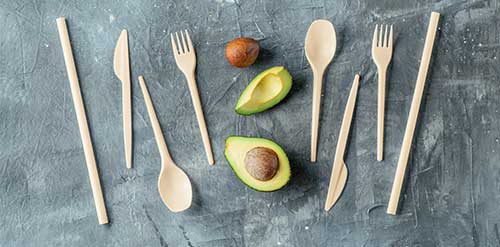Hyundai Motorstudio Senayan Park
Hyundai Motorstudio Senayan Park
Newsroom
-
Bioplastics: A Simple Solution to Reduce Environmental Pollution
- Hyundai Motorstudio Senayan Park 2022.07.18
-
Plastic has long been known as a very multifunctional material. Not only packaging, plastic is also used for road-building materials, to car component parts. Unfortunately, plastic materials are the biggest source of water and soil pollution in the world. Every year there are 200 million tons of plastic waste on planet earth.
The good news is that there is now a bio-plastic innovation for reduce plastic waste . Bioplastic has become an alternative material for traditional plastic bags in various countries. As an alternative, bio-plastics are considered more environmentally friendly because they are made from agricultural waste such as corn starch or potato starch.
Bioplastics are 100% biodegradable by soil. In fact, it has been applied in various industries. Including agriculture, textile industry, medicine and product packaging. Bioplastics are expected to be able to meet the needs of 10% of the European plastic market within the next 10 years.
What is Bioplastic?
Bioplastics are sources of biodegradable plastics made from natural materials, such as cornstarch, potato starch, or other agricultural waste.
Different from traditional plastics, bio plastics are easily biodegradable in the natural environment. This means, bioplastics can reduce the impact of climate change and adopt a sustainable lifestyle for the earth.
Types of Bioplastics
Here are some types of bio plastics used in various industries:
1. Bioplastic material corn or potato starch
This type of flour-based bio-plastic is in great demand. Its blend with biodegradable polyester produces a type of bioplastic that is water resistant. Usually used for food packaging, shopping bags, and others.
2. Protein-based bioplastics
Next, bio-based plastics made from wheat and soy protein. Used in the automotive industry, as well as producing electronic components.
3. Bioplastic made from cellulose
Cellulose added to corn flour will produce bio-plastics with water-resistant and strong properties (not easily torn). It is ideal for high quality packaging materials.
4. Aliphatic polyester
There is an aliphatic bioplastic version that is commonly used. Such as polyhydroxyalkanoate (PHA), polyhydroxyhexanoate (PHH), poly-3-hydroxybutyrate (PHB), polyhydroxyvalerate (PHV).
5. Bioplastic made from fat
Bio-plastics made from fats or oils come from certain plants and animals.
Uses of Bioplastics in the Commercial Industry
The various uses of bio-plastics have been widely recognized in the industrial sector. In addition to packaging, there are several other functions of bio-plastics. Here are some of them:
1. Food and Beverage Container
Bioplastic material is ideal for use in the food and beverage industry because it is able to maintain the quality of the packaging. Stored food will be free from toxic chemicals and last longer.
2. Household and Kitchen Appliances
Bio plastic is made from renewable materials that can be alternative to conventional plastics for single-use household appliances and kitchen utensils.
For example, such as plastic bottles, cups, hangers, shelves, toys, buckets, and others.
3. Medical Equipment
The medical industry can also take advantage of the use of bio-plastics. Various medical devices that use non-toxic bioplastics. In the medical sector, bioplastics can be used for cardiac surgery sutures, orthopedic pins, dental implants, skin staplers, soluble medical screws, and others.
4. Electronic Components
Electronic goods that use bio-plastics such as touch screen computer cases, keyboards, earphones , cell phones, loudspeakers, laptops, game consoles, cell phone cases, mice, vacuum cleaners, and others.
5. Car Industry
Plastic products have become an important part of the automotive sector. However, plastic waste is difficult to recycle. That is why, the automotive sector has turned to bio-plastics such as bio-polyester and bio-polyamide.
Being easily decomposed by soil, bioplastic materials are also sturdy and strong. Widely used as a car dashboard material, exterior and interior features, floor mats, car sunroofs, and others.
Advantages of Bioplastics
Bio plastic has properties similar to conventional plastic, but there are a number of advantages that make it a favorite packaging for environmentally friendly businesses. Among them:
1. Reducing Carbon Emissions
Bioplastic only produces low carbon emissions during the manufacturing process. Especially, when compared to ordinary plastic waste.
2. Improved Biodegradability
Bio plastic can decompose naturally in 3-6 months, unlike ordinary plastic waste which takes hundreds of years.
3. Recyclable
Bio plastics can be recycled and help consumers to be more environmentally responsible.
4. Reduce Plastic Waste
Bioplastic can be used as compost or soil fertilizer. This means, it will reduce the stack plastic waste that must be managed.
5. Improved Food Safety
Biodegradable products are made using natural ingredients. Thus, it does not contain toxic chemicals or health risks. Bioplastic is safe to use for food or beverage packaging. Making it a practical and environmentally friendly choice.
6. Natural Resource Efficiency
Based on the current level of consumption, about 47 years from now, oil will run out. After that, the world must turn to alternative sustainable natural resources.
Ordinary plastic production accounts for 18% of total worldwide petroleum consumption. By switching to bioplastics, we can reduce our consumption of petroleum and conserve the planet's finite natural resources.
7. Profitable Business
About 75% of consumers are willing to pay more for environmentally friendly products. Therefore, bio-plastics are very supportive of environmentally conscious businesses.
The bioplastic market is expected to grow and develop rapidly in the coming years. Because, many industries are modern-minded and apply sustainable concept .
Bioplastic is the solution to reduce environmental pollution due to conventional plastic waste. Although at first glance the shape is the same, but bio-plastic packaging is able to preserve natural resources and is more responsible. Therefore, bio-plastic is an alternative solution to plastic that is much more environmentally friendly.




